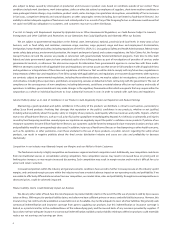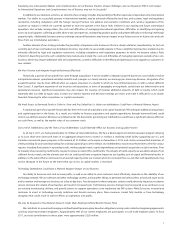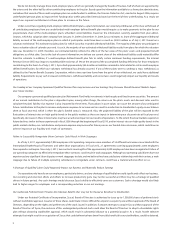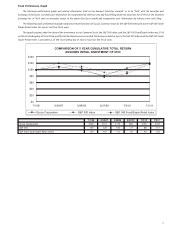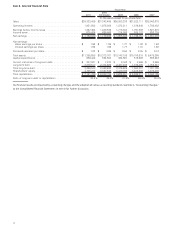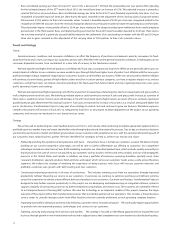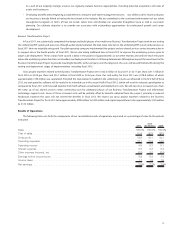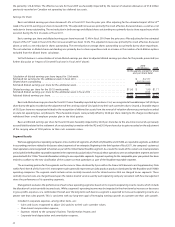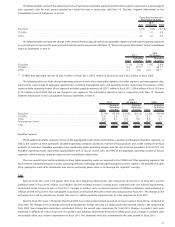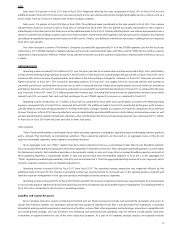Sysco 2011 Annual Report Download - page 38
Download and view the complete annual report
Please find page 38 of the 2011 Sysco annual report below. You can navigate through the pages in the report by either clicking on the pages listed below, or by using the keyword search tool below to find specific information within the annual report.• Basic and diluted earnings per share in fiscal 2011 were $1.96, a decrease of 1.5% from the comparable prior year period. After adjusting
for the estimated impact of the 53
rd
week in fiscal 2010, this would have been an increase of 0.5%. This adjusted increase is primarily a
result of the factors discussed above. Basic and diluted earnings per share for fiscal 2011 were favorably impacted by two items. First, we
recognized a favorable impact of $0.05 per share due to the gains recorded on the adjustment of the carrying value of corporate-owned
life insurance (COLI) policies to their cash surrender values. Second, a favorable impact of $0.02 per share was recognized related to the
recognition of deferred tax assets from the reversal of valuation allowances previously recorded on state net operating loss carryforwards.
These favorable impacts were partially offset by $0.04 per share relating to the charge recorded upon withdrawal from a multi-employer
pension plan in the third quarter. Basic and diluted earnings per share for fiscal 2010 were favorably impacted by $0.05 per share due to
the one-time reversal of a previously accrued liability related to the settlement of an outstanding tax matter with the IRS and $0.04 per
share due to gains recorded on the adjustment of the carrying value of COLI policies to their cash surrender values.
Trends and Strategy
Trends
General economic conditions and consumer confidence can affect the frequency of purchases and amounts spent by consumers for food-
away-from-home and, in turn, can impact our customers and our sales. We believe the current general economic conditions, including pressure on
consumer disposable income, have contributed to a slow rate of recovery in the foodservice market.
We have experienced higher levels of product cost inflation this fiscal year as compared to fiscal 2010. While we are generally able to pass on
modest levels of inflation to our customers, we were unable to pass through fully these higher levels of product cost inflation with the same gross
profit percentage without negatively impacting our customers’ business and therefore our business. While we cannot predict whether inflation
will continue at current levels, periods of high inflation, either overall or in certain product categories, can have a negative impact on us and our
customers, as high food costs can reduce consumer spending in the food-away-from-home market, and may negatively impact our sales, gross
profit, operating income and earnings.
We have also experienced higher operating costs this fiscal year from increased pay-related expense due to increased sales and gross profit as
well as higher pension and fuel costs. We believe pay-related expense could continue to increase if sales and gross profit increase, as a portion of
these costs is variable in nature. Pension costs will decrease in fiscal 2012 primarily due to higher returns on assets of Sysco’s company-sponsored
qualified pension plan (Retirement Plan) during fiscal 2011. Fuel costs are expected to increase in fiscal 2012 as a result of anticipated higher fuel
prices. Our Business Transformation Project is a key part of our strategy to control costs and continue to grow our business. We believe expenses
related to the project will increase in fiscal 2012 as compared to fiscal 2011 as we prepare to begin deployment of the project to our operating
companies and increase our headcount in our shared services center.
Strategy
We are focused on optimizing our core broadline business in the U.S. and Canada, while continuing to explore appropriate opportunities to
profitably grow our market share and create shareholder value through adjacent and international businesses. Day-to-day, our business decisions
are driven by our mission to market and deliver great products to our customers with exceptional service, with the aspiration of becoming each of
our customers’ most valued business partner. We have identified five strategies to help us achieve our mission and vision:
•Profoundly enriching the experience of doing business with Sysco: Our primary focus is to help our customers succeed. We believe that by
building on our current competitive advantages, we will be able to further differentiate our offering to customers. Our competitive
advantages include our sales force of over 8,000 marketing associates; our diversified product base, which includes quality-assured Sysco
brand products; the suite of services we provide to our customers such as business reviews and menu analysis; and our wide geographic
presence in the United States and Canada. In addition, we have a portfolio of businesses spanning broadline, specialty meat, chain
restaurant distribution, specialty produce, hotel amenities and export which serves our customers’ needs across a wide array of business
segments. We believe this strategy of enriching the experience of doing business with Sysco will increase customer retention and
profitably accelerate sales growth with both existing and new customers.
•Continuously improving productivity in all areas of our business: This includes removing costs from our operations through improved
productivity without impacting our service to our customers. In particular, we continue to optimize warehouse and delivery activities
across the corporation to achieve a more efficient delivery of products to our customers. Our multi-year Business Transformation Project is
designed to help further improve productivity. In this project, we are developing and implementing an integrated software system to
support a majority of our business processes to further streamline our operations and reduce costs. These systems are commonly referred
to as Enterprise Resource Planning (ERP) systems. We view the technology as an important enabler of this project; however the larger
outcome of this project will be from transformed processes that standardize portions of our operations. This includes a shared business
service center to centrally manage certain back-office functions that are currently performed at each operating company location.
•Expanding our portfolio of products and services by initiating a customer-centric innovation program: We continually explore opportunities
to provide new and improved products, technologies and services to our customers.
•Exploring, assessing and pursuing new businesses and markets: This strategy is focused on identifying opportunities to expand the core
business through growth in new international markets and in adjacent areas that complement our core foodservice distribution business.
14




